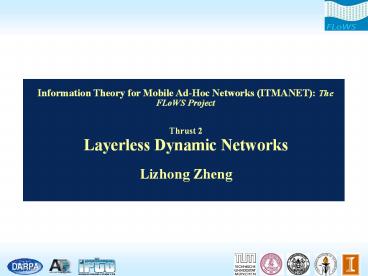Staffer Day Template PowerPoint PPT Presentation
Title: Staffer Day Template
1
Information Theory for Mobile Ad-Hoc Networks
(ITMANET) The FLoWS Project
Thrust 2 Layerless Dynamic Networks Lizhong
Zheng
2
New Paradigms for Upper Bounds
Application Metrics and Network Performance
3
Layerless Dynamic Networks
- Dynamic Separation of functionalities by
different time scales no longer optimal. - Time varying channel/network environments, lack
of information, high overhead costs - Data/side information available in a variety of
forms, with a wide range of quality/precision/reli
ability - Broadcasting and interference, beyond
point-to-point communications - Layerless Our solution to the dynamic problems
- Network information theory cooperative/cognitive
transmissions, relay and soft information
processing, feedbacks - Heterogeneous data processing, prioritizing data
by different levels of reliability networking
based on new interface to the physical layer - The principle of network coding,
transmit-collect-combine pieces of information,
generalized form and coordination in dynamic
networks - Operating with imperfect side information,
robustness and universal designs.
4
Thrust Areas
- Network information theory
- Multi-terminal communication schemes with
cooperative and cognitive signaling, interference
mitigation, broadcast/relay - Generalizing network coding
- Dynamic environment and feedbacks
- Structured code designs
- Efficient transmission of heterogeneous data
- Universal and robust algorithms
- Reducing the requirement of coordination
overhead - Feedback
- Moving towards larger networks
5
Recent Thrust AchievementsRelaying, forwarding,
and combining soft information
- Likelihood forwarding Koetter
- General relaying for multicast Goldsmith
- DMT for multi-hop networks -- Goldsmith
- Cognitive interference / Z channels -- Goldsmith
- Based on generalized Gelfand-Pinsker channel
- Optimal structure for interference.
- Interference forwarding -- Goldsmith
- Taking advantage of the structure of codebooks
- Forwarding interference so it can be decoded and
cancelled. - MIMO cognitive networks -- Goldsmith
- Spatial degrees of freedom for cognition and
cooperation - Cooperation in broadcasting, multiple prime
users.
6
Recent Thrust AchievementsStructured code
designs
- Broadcasting with layered source codes
Goldsmith - Generalized capacity/distortion for joint source
channel codes Effros Goldsmith - UEP performance limits and applications -- Zheng
- Theoretical limits for heterogeneous data
transmissions - Unifying resource allocation between control and
data messages, a new interface to the physical
layer. - Layered joint source channel codes -- Medard
Zheng - Distortion-diversity tradeoff a performance
metric for dynamic source-channel problems - Multiple descriptions carried by layered channel
codes
7
Recent Thrust Achievements Generalized Network
Coding
- Using feedbacks with linear network coding
Medard - ACK used to estimate transmission time and
channel condition - Improve delay/energy efficiency for TDD systems
- Contents feedback with Network Coding Effros
- Avoid unnecessary retransmissions
- Strictly increase capacity region for the
butterfly network and multi-terminal source
coding. - Distributed source coding with network coding
Effros - Classical example of source networks
- extended with network coding
8
Recent Thrust Achievements Feedback, channel
memory, and dynamics
- Network coding with feedback
- Indecomposable finite state channel with Feedback
-- Goldsmith - Appropriate model of dynamics
- Tx-Rx synchronization to achieve the maximum over
all channel states - Generalization to finite state broadcast channels
(FSBC) - Goldsmith - Superposition codetree at the encoder
- User cooperation included
- DMDT for multi-hop MIMO Relay Network
- - Goldsmith
- Diversity-Multiplexing-Delay tradeoff
- Optimal ARQ protocol fractional variable ARQ
- Control principles for feedback channels --
Coleman - Feedback channel as a control problem
- Low complexity iterative encoder to achieve
capacity
9
Recent Thrust AchievementsTowards Larger
Networks
- Interference Mitigating Mobility Strategies
Moulin - Using mobility to actively avoid interference to
others - Optimal mobility strategy to dynamically enlarge
capacity region. - Scaling law for heterogeneous large networks
Shah - Tree networks for hierarchical cooperative relay
- Arbitrary traffic/ node placement.
- Networks with Side Information Effros
- Distributed source coding joint with network
coding - Successive refinement for source / side
information for multiple sinks. - Graphical scheduling -- Medard Koetter
- Hyper graph to describe conflicts
- Distributed algorithms for hyperarc scheduling.
10
Thrust Synergies
Thrust 1 New Paradigm of outer bounds
Provide building blocks for large networks,
translate design constraints into network
modeling assumptions
Performance benchmark and design justification
UEP bit-wise. vs message-wise -- Zheng
Network equivalence Effros, Medard Koetter
Thrust 2 Dynamic Network Information theory
improving performance in presence of
interference, cooperation, and dynamic environment
Provide achievable performance region, based on
which distributed algorithms and resource
allocation over large networks are designed
Guide problem formulation by identifying
application constraints and relevant performance
metrics
Network scalability, robust and distributed
algorithms
Cooperative models for wireless NUM Boyd
Goldsmith
Thrust 3 Application Metrics and Network
Performance
11
Thrust 2 Achievements Previous
Dynamic Network Information Theory
CSI, feedback, and robustness
Structured coding
12
Thrust 2 Achievements Recent
Dynamic Network Information Theory
CSI, feedback, and robustness
Structured coding
13
Thrust Alignment with Phase 2 Goals
- Evolve results in all thrust areas to examine
more complex models, robustness/security, more
challenging dynamics, and larger networks. - Network coding for classical distributed source
coding problem - Impact of dynamics for feedback (BC) channels
- Multiple cooperative/cognitive scenarios
- Network coding with feedback
- Demonstrate synergies between thrust areas
- Research clustering within the thrust
- Dynamic channel models with novel multi-user
signaling - Network coding used for distributed source
coding - Synergies between thrusts
- Distributed algorithms for scheduling in networks
- Models for wireless NUM with interference and
dynamics (focus talk. Boyd Goldsmith) - Network coding capacity with selfish users (focus
talk, Effros) - Demonstrate that key synergies between
information theory, network theory, and
optimization/control lead to at least an order of
magnitude performance gain for key metrics. - Gains by modeling dynamics, allowing
cooperative/cognitive transmissions, and
utilizing feedbacks - Gains by novel signaling (interference forwarding
and message embedding)

